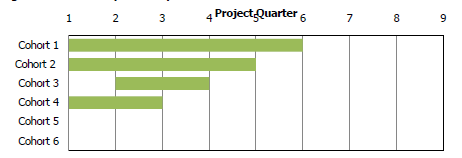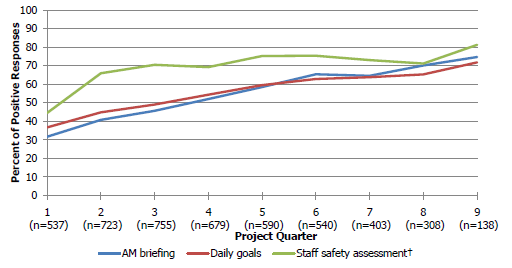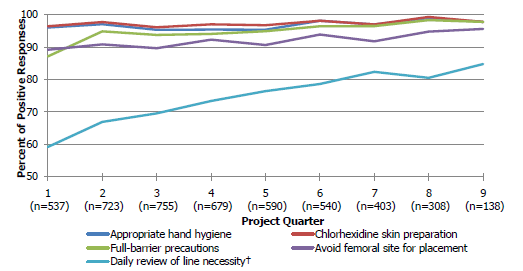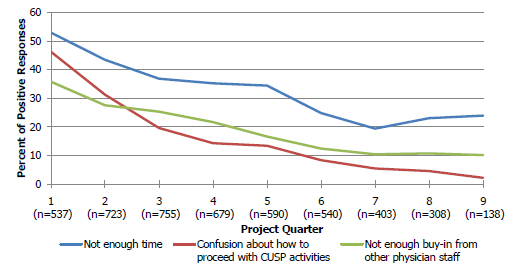Team Checkup Tool
Section Summary
- Units were requested to complete a Team Checkup Tool (TCT) assessing CUSP adoption, implementation, and barriers.
- The proportion of units using specific project steps (a.m. briefing, daily goals, observing rounds) increased over time.
- More than 80 percent of units consistently used the following CLABSI reduction steps over time: hand hygiene, chlorhexidine skin preparation, full-barrier precautions during line insertion, avoidance of femoral site for placement, and removal or review of unnecessary lines.
- At baseline, units identified the following as the top barriers to progress: 1) not enough time, 2) confusion about how to proceed with CUSP activities, and 3) not enough buy-in from other physician staff. Over time, the proportion of units perceiving these as barriers decreased.
Participating units were requested to complete a Team Checkup Tool (TCT) evaluating three primary domains: adoption of CUSP activities, implementation of CLABSI reduction steps, and progress barriers. Initially, cohorts were requested to complete the TCT on a monthly basis. Due to data collection burden, the collection schedule was modified in December of 2010 to quarterly, and the survey instrument was shortened. Both versions of the survey instrument can be found in Appendix F. Figure 19 and Figure 20 illustrate cohorts providing survey responses by instrument version over time. Results include data from all units regardless of ICU status due to low submission rates. Questions from domains were selected for presentation only if all cohorts were exposed to the question. For example, "Culture debriefing" is found in version one of the instrument but not version two, and therefore results for this domain are not shown below.
Although survey response was low (~18 percent completion), results found an increase in "adoption of CUSP activities" and "implementation of CLABSI reduction steps" domains over time and a decrease in "progress barriers" with time. Specifically, the proportion of units undertaking AM briefing, daily goals, and observing rounds increased over time. More than 80 percent of units consistently used hand hygiene, chlorhexidine skin preparation, full-barrier precautions during line insertion, and avoidance of femoral site for placement. Reported removal or review of unnecessary lines also increased over time. The top three unit progress barriers were 1) not enough time, 2) confusion about how to proceed with CUSP activities, and 3) not enough buy-in from other physician staff. Proportion of units perceiving these three areas as barriers decreased over time.
Figure 19. TCT completion by cohort—version one

Figure 20. TCT completion by cohort—version two

Figure 21. Adoption of CUSP activities

† Only data in the 2nd version of TCT were included.
Figure 22. Implementation of CLABSI reduction steps

† Only data in the 2nd version of TCT were included.
Figure 23. Top three unit progress barriers




